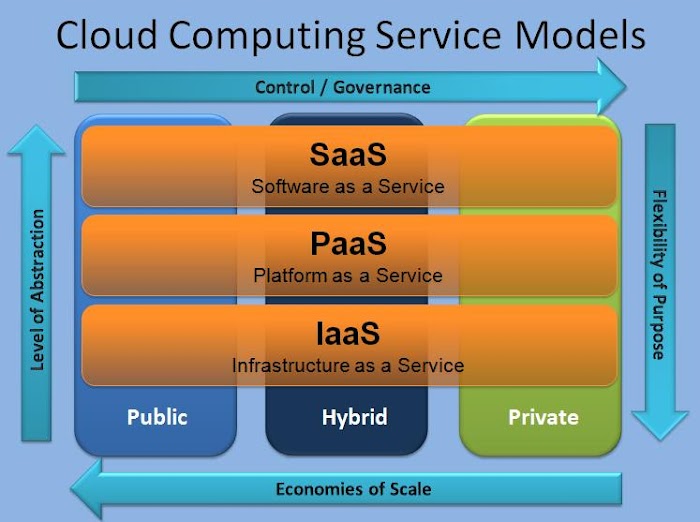
What Is Cloud Service Models? IaaS Vs PaaS Vs SaaS
What Is Cloud Service Models? IaaS Vs PaaS Vs SaaS
Three type of main Cloud service models include:
- IaaS (Infrastructure as a Service)
- PaaS (Platform as a Service)
- SaaS (Software as a Service)
Variations from the above-mentioned base models, such as storage as a service, security as a service, etc., keep emerging in the market.
Cloud Service Models With Examples
What Is Infrastructure As A Service (IaaS):
As the name suggests, it provides computing infrastructure and other resources such as virtual-machines, block or file-based storage, load balancers, IP addresses, virtual networks etc. Infrastructure as a Service (IaaS) delivery model represent a self-contained IT environment comprised of infrastructure-centric IT resource that can be access and managed via cloud service-based interface and tools. IaaS environment can be including hardware, network, connectivity, operating system and other raw IT resources. In general purpose of an IaaS environment is to provide cloud consumers with a high level of control and responsibility over its configuration and utilization.
Infrastructure As A Service (IaaS) Example: Azure Virtual Machines, Amazon EC2, Rackspace.
What Is Platform As A Service (PaaS):
As the name suggests, it provides you computing platforms which typically includes operating system, programming language execution environment, database, web server etc.
The PaaS delivery model represent a pre-define “ready-to-use” environment typically comprised of already deploy and configured IT resource. Common reasons a cloud consumer would use and invest in a PaaS environment:
- The cloud consumer wants to extend on-premise environment into the cloud for scalability and economic purposed.
- The Cloud consumer use the ready-made environment to entirely substitute an on-premise environment.
- The Cloud consumer wants to become a cloud provider and deploy its own cloud service to be made available to other external cloud consumers.
Platform As A Service (PaaS) Example: AWS Elastic Beanstalk, Windows Azure, Heroku Etc.
What Is Software As A Service (SaaS)
Software as a Service (SaaS) Provides on-demand software and there is no need to worry about installation and setup of the application. An entire marketplace exists around SaaS product that can be leased and used for deferent purposes and via referent terms.
A cloud consumer is generally granted very limited administrative control over a SaaS implementation.
Software As A Service (SaaS) Example: Microsoft Office 365, Salesforce.Com.
What Is IDaaS (Identity As A Service)
Identity as a Service (IDaaS) is the authentication infrastructure that is hosted and managed by a third-party service provider.
Types of identities available are:
- Internal Users: Internal users are part of an organization such as employees and maintenance personnel.
- External Users: External users are those who are using the product or service implemented by an organization such as business partners.
- Consumers: Users who use authentication mechanisms to utilize the application such as Facebook.
Core Aspects Of IDaaS:
- Identity Governance and Administration (IGA): Provision cloud users and enable password reset functionality.
- Access: User authentication, SSO, and such authorization-based integration.
- Intelligence: Identity access log monitoring and reporting.
Multi-factor authentication is one such type of application such as GitHub where users need to submit multiple factors to access the data.
What Is DaaS(Data As A Service)
Data as a service (DaaS) is another cloud service model which is a little bit more ambiguous than some of the other cloud service models.
- It refers to the fact that data stored in the cloud is available over the network remotely on demand, anytime of day using any type of device where data is stored on cloud service provider infrastructure.
- The data can be included of anything such as files, entire databases, photographs, videos, website data. So it’s quite ambiguous and generic in that way. Geographic location is irrelevant because when it comes to storing data in the cloud, cloud providers have the option of replicating data between their data centers around the globe, thus making the data that the user needs locally available.
What Is BPaaS(Business Process As A Service)
BPaaS (Business process as a service) is another cloud service model that is anything required for the business to function, although it may not be related to the nature of the business. For example, of a business process might include payment card processing, if you want your customers to be able to purchase our goods of services with the debit card or credit card, that payment has to be processed somewhere somehow. So, you might outsource that and have it run in the cloud.
- Business Process as a Service is considered a higher-level cloud service model that sits upon things like SaaS, PaaS, IaaS and like all cloud services, business processes that are running in the cloud are delivered remotely over the network.
What Is CaaS(Communication As A Service)
CaaS (communication as a service) is another cloud service model that involves anything like phones, emails, messaging, video conferencing which are outsourced, handled and also responsible by cloud provider.
- So, the service would be remotely available over the network. Now in some cases when it comes to CaaS, you might still have physical hardware on premises. For example, you might have cameras for video conferencing, you might have voiceover IP telephones, physically at your site. But their configuration and how they are managed would be handled in the cloud. So, voiceover IP is a good example of CaaS being hosted and being the responsibility of the cloud provider.
- Instant Messaging is another great example, we wouldn’t have to have servers under our control that would allow Instant Messaging, that would be the responsibility of the cloud provider.








0 Comments: